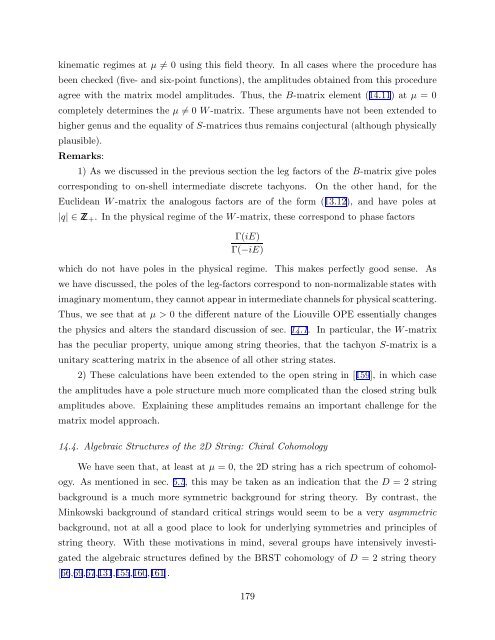arXiv:hep-th/9304011 v1 Apr 5 1993
arXiv:hep-th/9304011 v1 Apr 5 1993
arXiv:hep-th/9304011 v1 Apr 5 1993
Create successful ePaper yourself
Turn your PDF publications into a flip-book with our unique Google optimized e-Paper software.
kinematic regimes at µ ≠ 0 using <strong>th</strong>is field <strong>th</strong>eory. In all cases where <strong>th</strong>e procedure has<br />
been checked (five- and six-point functions), <strong>th</strong>e amplitudes obtained from <strong>th</strong>is procedure<br />
agree wi<strong>th</strong> <strong>th</strong>e matrix model amplitudes. Thus, <strong>th</strong>e B-matrix element (14.11) at µ = 0<br />
completely determines <strong>th</strong>e µ ≠ 0 W -matrix. These arguments have not been extended to<br />
higher genus and <strong>th</strong>e equality of S-matrices <strong>th</strong>us remains conjectural (al<strong>th</strong>ough physically<br />
plausible).<br />
Remarks:<br />
1) As we discussed in <strong>th</strong>e previous section <strong>th</strong>e leg factors of <strong>th</strong>e B-matrix give poles<br />
corresponding to on-shell intermediate discrete tachyons.<br />
On <strong>th</strong>e o<strong>th</strong>er hand, for <strong>th</strong>e<br />
Euclidean W -matrix <strong>th</strong>e analogous factors are of <strong>th</strong>e form (13.12), and have poles at<br />
|q| ∈ Z + . In <strong>th</strong>e physical regime of <strong>th</strong>e W -matrix, <strong>th</strong>ese correspond to phase factors<br />
Γ(iE)<br />
Γ(−iE)<br />
which do not have poles in <strong>th</strong>e physical regime. This makes perfectly good sense.<br />
we have discussed, <strong>th</strong>e poles of <strong>th</strong>e leg-factors correspond to non-normalizable states wi<strong>th</strong><br />
imaginary momentum, <strong>th</strong>ey cannot appear in intermediate channels for physical scattering.<br />
Thus, we see <strong>th</strong>at at µ > 0 <strong>th</strong>e different nature of <strong>th</strong>e Liouville OPE essentially changes<br />
<strong>th</strong>e physics and alters <strong>th</strong>e standard discussion of sec. 14.1. In particular, <strong>th</strong>e W -matrix<br />
has <strong>th</strong>e peculiar property, unique among string <strong>th</strong>eories, <strong>th</strong>at <strong>th</strong>e tachyon S-matrix is a<br />
unitary scattering matrix in <strong>th</strong>e absence of all o<strong>th</strong>er string states.<br />
2) These calculations have been extended to <strong>th</strong>e open string in [159], in which case<br />
<strong>th</strong>e amplitudes have a pole structure much more complicated <strong>th</strong>an <strong>th</strong>e closed string bulk<br />
amplitudes above. Explaining <strong>th</strong>ese amplitudes remains an important challenge for <strong>th</strong>e<br />
matrix model approach.<br />
14.4. Algebraic Structures of <strong>th</strong>e 2D String: Chiral Cohomology<br />
We have seen <strong>th</strong>at, at least at µ = 0, <strong>th</strong>e 2D string has a rich spectrum of cohomology.<br />
As mentioned in sec. 5.5, <strong>th</strong>is may be taken as an indication <strong>th</strong>at <strong>th</strong>e D = 2 string<br />
background is a much more symmetric background for string <strong>th</strong>eory.<br />
As<br />
By contrast, <strong>th</strong>e<br />
Minkowski background of standard critical strings would seem to be a very asymmetric<br />
background, not at all a good place to look for underlying symmetries and principles of<br />
string <strong>th</strong>eory. Wi<strong>th</strong> <strong>th</strong>ese motivations in mind, several groups have intensively investigated<br />
<strong>th</strong>e algebraic structures defined by <strong>th</strong>e BRST cohomology of D = 2 string <strong>th</strong>eory<br />
[66,69,67,131,155,160,161].<br />
179
















